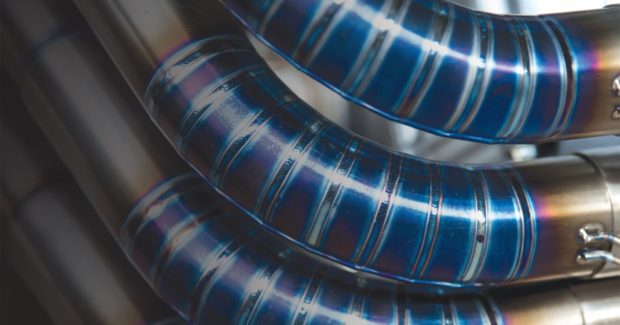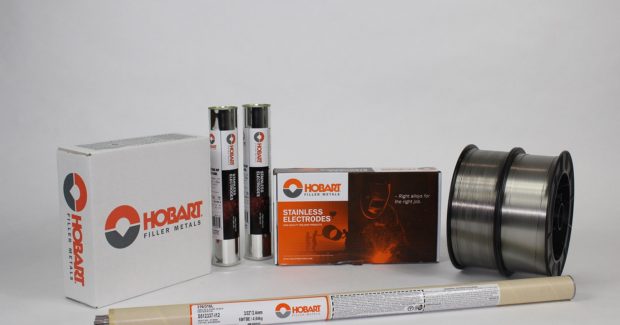Understanding Stainless Steel Filler Metals
The properties of stainless steel offer corrosion resistance, toughness and strength, a good appearance and longer useful life. But there are some challenges when welding stainless steel. Consider these tips and best practices, including proper filler metal selection, to get the most from stainless steel welding applications.
Posted: February 16, 2017
Stainless steel is a common material choice in many welding applications, especially critical ones that require corrosion resistance, toughness and strength, along with a specified appearance. These applications can include automotive parts, medical equipment, tractor trailers and storage containers in the food and beverage industry. Because of its properties, stainless steel also typically offers longer useful life. However, there are some challenges when welding stainless steel. Consider these tips and best practices, including proper filler metal selection, to get the most from stainless steel welding applications.
CHALLENGES WITH STAINLESS
Among the common challenges to welding stainless steel is oxidation of the material. Oxidation, which can occur from improper shielding of the material from the atmosphere, causes stainless steel to lose its corrosion-resistance properties. In addition, carbide precipitation can occur when stainless steel is held at a high temperature for a long period. This also has an effect on the corrosive-resistance properties of stainless steel. Another challenge is warpage. Stainless steel has less thermal conductivity than some other materials, which means the heat tends to stay in the area being welded rather than spreading into the rest of the workpiece. This concentration of heat can cause warpage, which can result in costly and time-consuming rework to straighten and/or weld parts again.
In some critical applications, controlling ferrite in the weld deposit may be necessary. Small amounts of ferrite in an austenitic weld deposit help prevent weld cracking. However, large amounts of ferrite should be avoided in weldments used for low-temperature service due to low toughness at these temperatures. Weldments in service above 1,000 deg F should also be low in ferrite. Consult a trusted distributor or filler metal manufacturer if you think you may need ferrite-controlled filler metals. Anticipating these issues and taking care to use appropriate pre- and post-weld cleaning, as well as proper shielding of the weld, can help prevent issues with warpage and oxidation.
KEY CONSIDERATIONS
In addition to the challenges mentioned above, successfully welding stainless steel requires selecting the proper filler metal, welding process and weld position.
- Filler metal selection: The first issue to consider is what type of stainless steel is being welded in order to match the stainless steel filler metal properly to the base material. Stainless steel filler metals come in a variety of American Welding Society (AWS; Miami, FL) classes to suit a number of applications. Consulting a guide or chart from a filler metal manufacturer, such as the one found on the Hobart WeldApp (iPhone version or for Android), can help determine the best filler metal options. For example, when welding AISI 304 to AISI 304, 308 filler metal is recommended. However, when welding ASIS 304 to AISI 309, using 309 filler metal is recommended. Using 309 filler metal is also recommended for welding most stainless steels to carbon and low alloy steels.
- Welding process: The next consideration is the welding process. This choice depends on many factors, including material thickness, cost considerations, operator skill level, whether the welding will be outside or inside, and the desired appearance and quality of the finished weld. A desire for low spatter levels, for example, lends itself to TIG or possibly submerged arc welding. If bead appearance is a priority, TIG may be the best choice. A stainless steel weld process selector guide can help in making the choice.
- Weld position: The final key consideration is weld position. The best weld position for a specific application is tied to the first two considerations of filler metal type and welding process. For example, a stick electrode with a “-15” designation is better for out-of-position welding than stick electrodes with “-16” or “-17” designations, which have greater puddle fluidity and can be hard to control.
TIPS FOR SUCCESS
When welding stainless steel, follow some general tips and best practices to achieve success. Stainless steel requires pre-weld cleaning to ensure corrosion resistance, along with post-weld cleaning to ensure a properly formed chromium oxide film on the surface. Because weld cleaning is so critical in stainless applications, it’s important to use the proper brushes and tools. Use a designated stainless steel brush for pre- and post-weld cleaning and for cleaning in between weld passes. This helps avoid contamination from a different brush material, which can result in corrosion down the road.
It’s also important to select the proper size of packaging for your stainless steel filler metals, which are typically available in smaller packages up to bulk drum sizes. Stainless steel filler metals are typically more expensive than carbon steel ones, making it important to purchase the most appropriate size package and making proper storage especially critical. Buying the proper amount helps you avoid wasting filler metal – and wasting money. Consider a filler metal manufacturer that offers a comprehensive lineup of stainless steel filler metals that provides consistent results. For example, we have expanded our offerings with a family of stainless filler metal products that includes stick electrodes, as well as flux-cored, solid and metal-cored wire product lines.
STAINLESS STEEL BENEFITS
Because of the material’s unique properties, welding stainless steel requires careful attention to detail. Choosing the right filler metal for the needs of the application and material type are important to success with stainless steel, as is the chosen welding process. With their 10 percent to 30 percent chromium makeup, stainless steel filler metals have a relatively impervious refractory oxide film that is self-healing, and they provide good corrosion resistance, strength at higher temperatures and toughness in cold temperatures. It is important to take steps throughout the welding process to protect those characteristics.

















